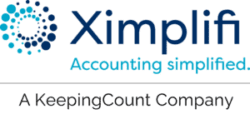The Struggle Connecting QuickBooks to Salesforce

Jesse Ehret
Founder & CEO

Salesforce is a well-known customer-relationship marketing (CRM) software that is widely used by many small-to-medium sized businesses, including short-term rental management companies. In this post, we discuss a few of the challenges users might run into when integrating QuickBooks with Salesforce, and present an alternative solution to build a seamlessly integrated tech stack.
If you’re using Salesforce, congratulations, you’re in good company. They bill themselves as the world’s number-one CRM platform and rightfully so.
Now, if you’re using Salesforce along with QuickBooks or are considering integrating these systems, there are some important things you should know. Some of us recall the Salesforce tagline “No Software” as it’s a cloud-based software-as-a-service offering. Unlike Salesforce, QuickBooks started out as desktop software and indeed many of its users are on the desktop version while others use QuickBooks Online. Besides where the platform resides, there are other major differences as QuickBooks Online delivers less functionality than the desktop version. And if you want to connect QuickBooks to Salesforce, your options are confusing at best.
QuickBooks offers its own Salesforce connector for QuickBooks Online Advanced. Look at its current customer ratings, which as of this writing scores a 2.6 out of 5, with comments such as:
- “It doesn’t work at all. Unable to import enough data, seems can’t even import more than 5. A waste of money.”
- “Randomly misses certain fields for some customers and sometimes doesnt (sic) even import the opportunity no matter what you do.”
- “The integration is extremely poor, it doesn’t work properly. It creates sales drafts for every opportunity that gets edited, even though the settings are configured to only bring in an opportunity once it is closed. It creates drafts for old opportunity records every time you edit an old opportunity, or merge an account with old opportunities.”
- “Terrible documentation, no support (not only that – they purposely obfuscate), a complete mystery to make it work properly. Look elsewhere.”
Those are direct quotes from QuickBooks customers using its connector to Salesforce. Of course, using the QuickBooks built-for-purpose connector from Intuit isn’t the only option as there are dozens of third parties offering much higher-rated connectors to Salesforce. This begs the question: Why doesn’t Intuit offer a solid connector to Salesforce? Why force customers to add yet another solution to their financial tech stack, instead of making it easy?
Part of the problem goes back to the very nature of Salesforce and QuickBooks. One is a true cloud platform, the other is software retrofitted for the cloud. When it was released, QuickBooks wasn’t designed for use with an application programming interface (API), since it was single-instance desktop software.
Speaking of instances, let’s consider that QuickBooks can’t handle multiple entities. Each entity needs its own instance of QuickBooks. As it is, multiple-entity consolidations can take hours to days to complete because the data from each entity must be exported and manually combined in spreadsheets regardless of any automation within a unique instance. Now it gets more problematic when you consider connecting multiple instances of QuickBooks to a single instance of Salesforce. What a mess, and you’re not going to go there.
Connecting QuickBooks to Salesforce – Why?
At this point, you might be thinking “is it even worth connecting QuickBooks to Salesforce?”
Let’s think about the negative consequences lacking an integration, primarily driven by cash constraints and missed revenue opportunities. Without a tight integration between the accounting system and Salesforce, it makes it harder to scale due to inefficiencies. When cash flow is tight, you can’t fund as many growth initiatives as you’d like and grow slows down. As a result, you might end up looking for additional funding to fuel growth. As well, you might find that you’re:
- Not hitting quotas/growth targets
- Experiencing flat or declining sales
- Missing customer commitments
- Unable to grow and react to market changes and opportunities
- Lacking visibility into costs, profit and loss
- Unable to maximize revenue
- Unable to optimize pricing and have ineffective discounting programs
All this creates unpleasant outcomes. Since your CRM isn’t connected to your accounting platform, you could end up losing market share, fail to meet customer needs, weaken your competitive position, miss revenue and growth opportunities, and make less informed decisions, leading to lower margins.
Instead, what if you could accelerate cash flow by 20% or more? How about saving scores of hours each month by not rekeying contracts, orders and projects, as well as eliminating manual billing? Or scaling billing 100% to 400% without increasing headcount?
This requires application integration that gives you and other stakeholders visibility and access to information at the right time. It also requires business-process automation and a modern, scalable integration platform.
With the right integration, you can streamline and automate the entire quote-to-cash process. Salesforce quotes can be turned into orders with a single click. This automatically triggers invoicing, ASC 606 revenue recognition and expense amortization for subscription-based services such as health clubs, internet service, phone contracts and SaaS. An immediate bidirectional synchronization between Salesforce and your financials allows you to maintain billing, revenue recognition and receivables in your financial platform while maintaining orders, contracts, projects, changes, and renewals in Salesforce. Pricing, billing and payments are easily visible to salespeople. Everyone stays up to date—without time-consuming rekeying of information, phone calls or emails, or jumping between systems.
Automating quote-to-cash increases sales and services productivity with:
- Creation and modification or orders, projects and contracts within Salesforce
- One-click conversion
- Email templates and notifications for renewals
- Automatic generation of renewal sales opportunities
- Increased visibility
- Support of reseller workflows
With Salesforce Chatter integration, collaboration should improve. A common view of contacts, accounts, products, prices, orders and contacts will improve efficiency. This will help you meet or exceed business-plan objectives; exceed customer expectations; improve communication, visibility and collaboration; and create a positive company culture.
You can track success with metrics that include:
- Time to market
- Net promoter score and percentage of repeat customers
- Average revenue per account
- Percentage of increased sales per customer
- Days sales outstanding
- Time to cash
- Quarter-over-quarter and year-over-year revenue increases
Of course, you can’t do any of this with a clunky integration between QuickBooks and Salesforce. First, you need to be on a single instance of QuickBooks, then choose the right one of dozens of the connectors out there (since QuickBooks’ own connector doesn’t work), and then more than likely engage with their professional services teams to map everything out so the connector works for your environment.
Fortunately, there’s a better solution than trying to connect QuickBooks to Salesforce. Lucky for you, Sage Intacct has built a hardened integration that allows its cloud-native financial management platform to connect directly into Salesforce. It’s as simple as point-click-connect. Sage Intacct customers report 30% to 75% shorter order and quote-to-cash cycles, DSO improvement and some report millions of dollars in accelerated cash flow. The Sage Intacct integration is prebuilt on the Salesforce platform, so there’s no need for expensive third-party integration, IT support, upgrades or custom consulting. It also comes with the Sage Intacct “Buy with Confidence” guarantee. So, instead of playing go-between with vendors, you can stay focused on your business.
Not sure what to do? Review the advantages of connecting your financial system with Salesforce as we’ve outlined here, then contact our team to start your path to cleaner financials with Sage Intacct today.
Additional Articles
5 Signs You've Outgrown QuickBooks
Frustrated with QuickBooks?
Download the white paper to determine if you need a more sophisticated system to meet your needs.
Contact Us.
Get in touch with us and we will get back to you.
Want to join our monthly newsletter?
View our Privacy Policy
Sage Partner SaaS Agreement










